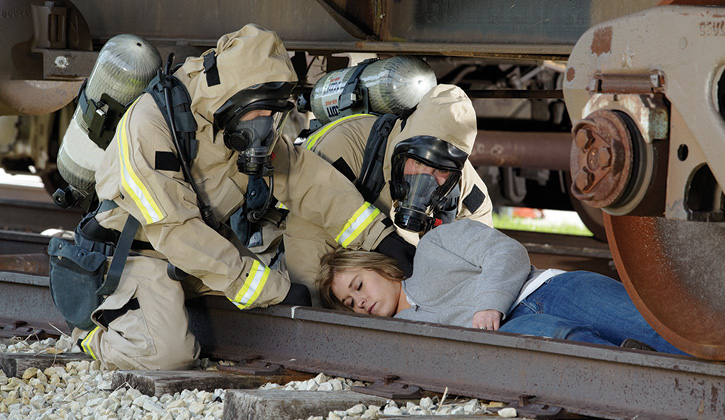
BY ALAN M. PETRILLO
Hazardous materials, big industrial incidents, and aircraft rescue and firefighting (ARFF) often require specialized personal protective equipment (PPE) to deal with a situation safely and in the most expeditious manner.
This means that firefighters confronting those situations are required to use a variety of specialty PPE that fits the particular scenario.
HAZMAT AND INDUSTRIAL PPE
Karen Lehtonen, vice president of innovation and product development for Lion, says that for hazmat and industrial response, Lion has two families of products. “The first is the Multi Threat MT94 PPE that meets [National Fire Protection Association (NFPA)] 1994, Standard on Protective Ensembles for First Responders to Hazardous Materials Emergencies and CBRN Terrorism Incidents, for Class 2 response, and it also meets NFPA 1992, Standard on Liquid Splash-Protective Ensembles and Clothing for Hazardous Materials Emergencies,” Lehtonen says. “Its GORE® CHEMPAK® Ultra Barrier fabric provides durable protection against toxic industrial chemicals and chemical warfare agents above immediately dangerous to life or health concentration levels while also providing improved mobility during tactical and technical operations.” Lehtonen points out that the MT94’s streamlined single-piece design combines durability, mobility, and comfort, “while its rugged construction allows the firefighter to perform in the most challenging of circumstances. The gear is impermeable, but the single layer trilaminate also is fire-resistant (FR), so it offers flash protection. It is usable for multiple wears and washings if not exposed or contaminated, and options include pockets, 3M Ventilated Trim™, hook-and-loop attachment points, modular lightweight load-carrying equipment, and playbook on forearm.”

1 Lion makes the MT94 PPE for hazardous materials, toxic industrial chemicals, and other types of responses. (Photos 1-2 courtesy of Lion.)

2 Firefighters wearing Lion’s MT94 hazmat gear undergo decon after an incident.
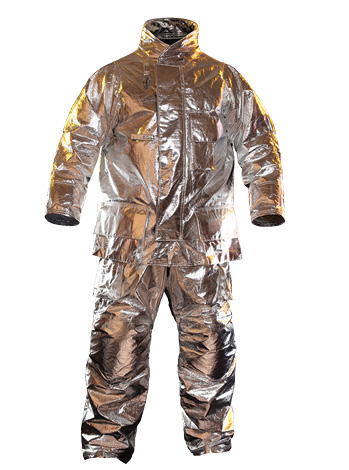
3 Fire-Dex makes proximity gear on its FXR design with two outer shell material options: Z-FLEX® SILVER™ with PBI fibers or CHOICE™ aluminized fabric. (Photo 3 courtesy of Fire-Dex.)
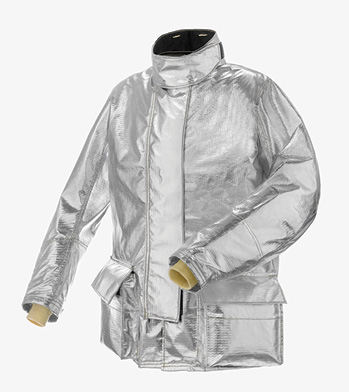
4 The B1 proximity coat made by Lakeland Industries Inc. features an aluminized PBI outer shell, a three-body panel design for increased range of motion, and ergonomically curved sleeves. (Photos 4-5 courtesy of Lakeland Industries Inc.)

5 Lakeland’s B1 proximity pant comes in a high back design to mate with the 32-inch-long B1 proximity coat.
Lion also makes its ERS extended-response extreme-dexterity specialty turnout gear, Lehtonen notes. “Our ERS gear meets NFPA 1994 Class 3 response and NFPA 1992 and is a warm-zone suit where a firefighter doesn’t need a self-contained breathing apparatus (SCBA) but is in a hazardous enough area where he might need a respirator,” she says. “The ERS also is a single-layer trilaminate but in a breathable fabric that is not fire-resistant. Wearing the ERS, a firefighter is able to work in the warm zone longer than if he were wearing MT94 in the hot zone.”
PROXIMITY GEAR: ARFF AND INDUSTRIAL USE
Todd Herring, director of marketing for Fire-Dex, says Fire-Dex makes proximity gear on the company’s FXR design of structural turnout gear as well as on its FXA classic gear. “The FXR is an ergonomic design that has minimized extra material and added strategically placed panels and seam construction to minimize coat rise when the arms are lifted over a firefighter’s head as well as having articulated arms and knees to give the gear an active posture design,” Herring says.
“Our FXR and FXA proximity gear is built as custom gear and has two outer shell material options: Z-FLEX® SILVER™, a seven-ounce multilayer aluminized fabric made with PBI® fibers, or CHOICE® aluminized fabric, a 7½-ounce aluminized basofil/para-aramid fabric,” he says. “Thermal barriers can be either DEFENDER™ M ELITE NP with a Lenzing FR™ aramid/nylon blend spun yarn plain weave face cloth or a DEFENDER M ELITE SL2 with a Lenzing rayon/para-aramid/nylon face cloth. Moisture barriers can be either STEDAIR® 3000 or CROSSTECH® BLACK.” DEFENDER M is produced by TenCate.
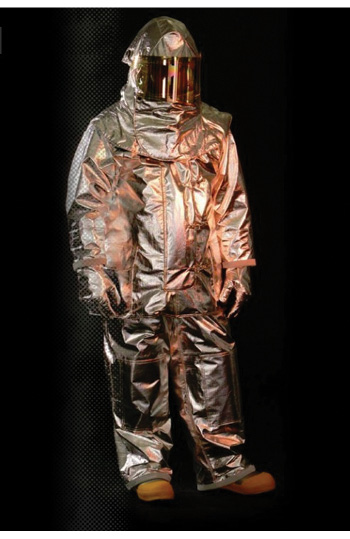
6 Veridian Fire Protective Gear makes the Vector model of proximity gear in a traditional three-layer style with an aluminized PBI/Kevlar knit outer shell. (Photos 6-7 courtesy of Veridian Fire Protective Gear.)
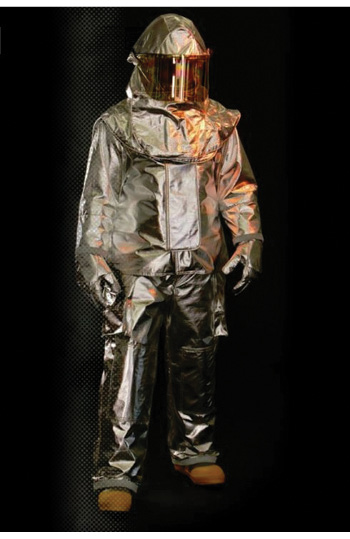
7 The Vector Lite series of proximity gear made by Veridian has a shorter style coat and higher waist pant than its Vector model.
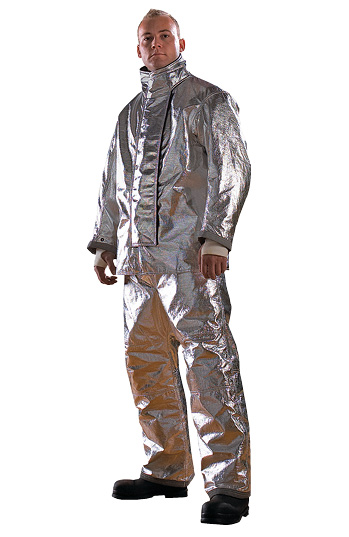
8 INNOTEX makes proximity gear with a choice of two outer shells: aluminized TECGEN®/Kevlar or aluminized Kevlar/PBI fabrics. (Photos 8-9courtesy of INNOTEX.)
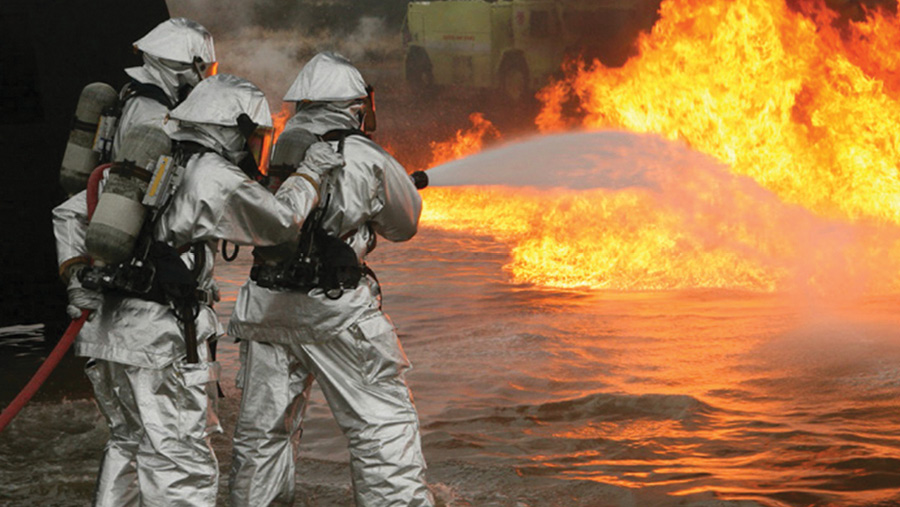
9 Firefighters outfitted in INNOTEX proximity gear tackle a flammable liquid fire.
Deana Stankowski, senior product marketing manager for Honeywell First Responder Products, says Honeywell makes aluminized proximity gear in both its Morning Pride® TAILS™ and its Viper PPE. Specialized options developed for its TAILS proximity gear, Stankowski points out, include removable/replacement crotch and seat, SCBA cover, half-height bellows pockets, leather or Ara-shield™ cuffs, and pant knee protection. “TAILS is our most popular brand and most flexible in terms of sizing and the number of options available,” she says.
“The VIPER has a more athletic fit and feel than the more traditional TAILS,” Stankowski notes. “The VIPER pant has more panels to give more ergonomic movement, and there also are more panels in the coat for the same reason,” she says. “VIPER also has a Thermal Enhancement System (TES™), she adds, that is designed to drastically increase thermal protective performance with no significant impact on total heat loss.”
John Therrien, national sales manager for fire at Lakeland Industries, Inc., says Lakeland makes two models of proximity gear: the B1 proximity coat and pant and the A10. Therrien notes that the B1 proximity coat features Lakeland’s easy-grip Drag Rescue Device, a three-body panel design for increased range of motion, an aluminumized PBI outer shell, set-in pleated ergonomically curved sleeves, double-stitched black Arashield coat cuff reinforcements, a DEFENDER M thermal liner, and a STEDAIR 3000 moisture barrier. The coat is 32 inches in length, while the pant has a high back design. Lakeland also makes the A10 aluminized proximity turnout coat and pant, with the coat having a 35-inch length and the turnout pant a standard rise back design.
Doug Dafler, director of sales for Veridian Fire Protective Gear, says Veridian makes the Vector model of proximity gear in the traditional three-layer style seen in structural firefighting PPE. “We use an aluminized PBI/Kevlar knit as the outer layer and offer a number of options on the moisture barrier and quilted thermal liner,” Dafler says. “Vector is very similar to our structural turnout gear in that it is a more traditional length garment, while our Vector Lite proximity gear is made in a style with a shorter coat and higher waist pant.”
Danny Roy, product manager of INNOTEX, says his company makes a model of proximity gear that offers a choice of two outer shells. “We make the gear with an outer shell of either aluminized TECGEN®/Kevlar or aluminized Kevlar/PBI,” Roy points out. “The rest of the gear is the same construction as our structural firefighting turnout gear, with a TenCate inner liner and a GORE RT7100 moisture barrier.”
ALAN M. PETRILLO is a Tucson, Arizona-based journalist, the author of three novels and five nonfiction books, and a member of the Fire Apparatus & Emergency Equipment Editorial Advisory Board. He served 22 years with the Verdoy (NY) Fire Department, including in the position of chief.

